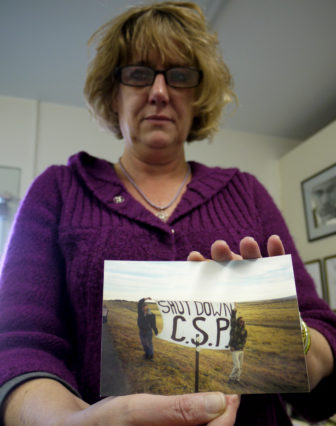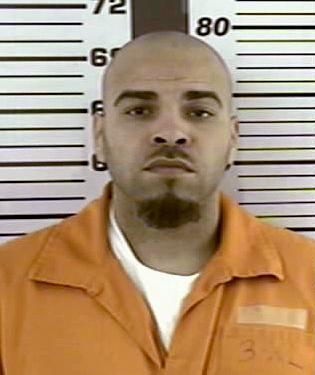How Colorado Reduced Solitary Confinement
It’s nearly been eliminated, while Wisconsin has made only a small reduction in solitary confinement.
Murder sparks leadership change
Raemisch became the executive director of the Colorado prison system in 2013 after the well-liked Clements was gunned down on his front doorstep by an inmate released directly to the streets after seven years in solitary confinement. Colorado has officially ended this practice for public safety reasons.
The murder was sadly ironic: It was Clements, at the direction of Hickenlooper and following pressure from advocacy groups and the Legislature, who spearheaded the push to severely curtail the use of isolation in Colorado prisons.
Speaking in the corrections headquarters conference room with a view of Pikes Peak in Colorado Springs, Raemisch recounted the rapid reduction in the state’s solitary confinement population: 1,500 prisoners in 2011, about 700 in 2013 and around 170 as of January. That number was back up to 185 as of May, Colorado DOC spokeswoman Laurie Kilpatrick said.
Raemisch’s goal is zero.

When Rick Raemisch left Wisconsin to take over leadership of the Colorado prison system, Democratic Gov. John Hickenlooper gave him a mandate: Reduce solitary confinement. Today, fewer than 200 prisoners are confined in 22-hour-a-day isolation in Colorado state prisons compared to 1,500 in 2011. Photo by Jerilee Bennett for the Wisconsin Center for Investigative Journalism.
During the interview, Raemisch addresses the allegation that the Colorado prison system was overstating the success of his reforms, including whether such prisoners were continuing to be released directly from solitary. In December, without acknowledging any wrongdoing, the department agreed to pay its former statistician Maureen O’Keefe $280,000 to settle her whistleblower complaint.
Raemisch disputes the claim that his department has “cooked the books.”
“We’ve had people question our numbers. I stand by our numbers 100 percent. There’s no question. I always have and I always will,” Raemisch said, adding that his agency has been “transparent” about its operations.

Rebecca Wallace, staff attorney for the American Civil Liberties Union of Colorado, says Rick Raemisch has helped to make reducing solitary confinement “palatable” for other corrections leaders. Photo courtesy of the American Civil Liberties Union of Colorado.
Rebecca Wallace, staff attorney for the American Civil Liberties Union in Colorado, said she cannot verify every statistic, but she credits Raemisch and his predecessor for the agency’s “remarkable” data collection and transparency.
“Compared to what’s happening around the country, you can just go onto the DOC’s website and you’ll see a level of information that you’re going to see very few other places,” Wallace said.
Wallace was part of an ACLU team that examined the department’s data to determine whether the reported gains were real. While identifying several shortcomings, the ACLU report told Raemisch that his reforms have improved public safety and “the humanity of Colorado’s prisons.”
“We recognize that because of policy changes under your administration, hundreds of men and women have been freed from long-term isolation and no doubt hundreds more will never endure it,” the report concluded. “Your work and public advocacy are not just affecting prisoners in Colorado, but are having positive ripple effects across the country and abroad.”
‘Cultural change’ in Colorado
Other prisoner advocates told the Center that the shift away from solitary in Colorado is real.

Christie Donner, executive director of the Colorado Criminal Justice Reform Coalition, has been fighting overincarceration and the use of solitary confinement for more than 20 years. This 1995 photo is from a protest of the state’s first “supermax” prison, the Colorado State Penitentiary. Inmates at the formerly all-solitary-confinement prison are now allowed to socialize with one another and interact with staff outside of their cells for four to six hours a day. Photo by Dee J. Hall of the Wisconsin Center for Investigative Journalism.
Among them is Christie Donner, executive director of the Denver-based Colorado Criminal Justice Reform Coalition. Beginning in the mid-1990s, Donner led the opposition against solitary confinement, including protests against the prison that now stands vacant in the high desert 115 miles south of Denver.
Donner said solitary was a “popular” solution to make prisons safer for staff and inmates.
“They always talk about gangs and murderers and sociopaths and really didn’t have any acknowledgement at all — zero — that there could be any mental health risk, either for somebody who didn’t have a mental health issue prior to going in, let alone for somebody that did have a mental illness when they went in,” she said.
Donner said Colorado is leading the way in shifting corrections away from solitary. “It is not just policy and practice change. … It’s an actual attitudinal, cultural change within corrections as a profession,” she said.
In Wisconsin, under a policy enacted in June 2015, the DOC has sharply reduced the maximum time in segregation for prisoners who violate prison rules, from 360 days to 90 days, with longer stints possible under some circumstances. But in practice, the Center revealed earlier this year that some inmates were not aware of the changes and had agreed to longer-than-maximum stints in isolation.
By comparison, Colorado currently has a maximum stay in restrictive housing of 30 days for most in-prison offenses. The exceptions are 60 days for murder and 45 days for manslaughter or kidnapping.
“When you start questioning everything, which is what we’ve done, does 30 days make any more difference than 15 days? The fact of the matter is, in our minds, it doesn’t,” Raemisch said. “So, 15 days is going to be the maximum number. We’re moving toward that. We will get to that.”
In the past, Colorado also confined some prisoners indefinitely for safety reasons; now the maximum for such administrative confinement is one year, Raemisch said.
“We are the only state that, when someone goes into restrictive housing, they know when they’re going to come out, and the absolute maximum — absolute maximum — is a year,” Raemisch said.
Less time in isolation
In fiscal year 2015, there were an average of 158 inmates serving up to one year in restrictive housing-maximum security in Colorado, spending up to 22 hours a day in their cells. The average length of confinement has dropped from 28 months in fiscal 2013 to eight months in fiscal 2015, according to agency figures.
For those with serious mental illness, isolation is banned. Now, such inmates must be offered a minimum of 10 hours a week outside their cells for therapy and 10 hours a week for other activities.
However, the ACLU was critical of a mass reclassification of mental health status launched in 2013 before Raemisch came on board that cut the percentage of prisoners listed as seriously mentally ill from 17 percent to 10 percent.
The report also found an “extremely high” number of prisoners were refusing at least part of the 10 hours a week of out-of-cell therapy, particularly group therapy. It recommended more mental health staff to provide individual counseling.
Raemisch said some prisoners are uncomfortable interacting with others after lengthy isolation. Clinicians coax them out using rewards such as extra canteen items or therapy dogs, he said.
Congregating for the first time
At Colorado State Penitentiary, where Raemisch served his solitary stint, Warden Travis Trani conducts a tour. Prisoners being confined for violating prison rules talk and play board games at tables in glassed-in common areas as the doors to their single cells stand open. These inmates are outside of their cells for between four and six hours a day in groups of between eight and 16, Trani said.
In the past, every prisoner was in his cell at least 23 hours a day.
“They would come out one hour a day — or I should say one hour five times a week — and they would recreate in that area,” Trani said, pointing to an empty cell. “They’d be there for an hour, they’d be allowed to shower, then they would go back to their cell. One offender at a time … The offenders never came out to congregate in these areas.”
In the gym, which had been closed to inmate use for 20 years until 2014, prisoners play basketball. When they leave the gym, they pass through a metal detector unrestrained.

A lawsuit by a mentally ill inmate forced construction of an outdoor recreation facility at the Colorado State Penitentiary seen here. Until the facility is completed later in 2016, prisoners will continue to have recreation time indoors. Plaintiff Troy Anderson had sued after spending 11 years confined at the prison with no outdoor recreation. Photo by Jen Friedberg for the Wisconsin Center for Investigative Journalism.
A fenced-in outdoor recreation area also is being added to the prison, which will offer inmates access to sunshine for the first time. The project is the result of a lawsuit filed by Troy Anderson, a mentally ill inmate who had spent 11 years in solitary confinement there. Ruling in 2012, a federal judge described the prison’s conditions as “a paradigm of inhumane treatment.”

Laura Rovner, a University of Denver associate law professor who teaches in the school’s Civil Rights Clinic, says the Colorado Department of Corrections has shown “enormous progress” in reducing solitary confinement in recent years. Photo courtesy of the University of Denver.
“We won on the issue of the need for people to be able to go outside, and that it was a violation of the Constitution that they couldn’t,” said Laura Rovner, a University of Denver associate law professor who teaches in the school’s Civil Rights Clinic, which handled the case.
Rovner recalled one prisoner who had spent 20 years in isolation at the prison; she said his skin was “translucent” from lack of exposure to the sun. Rovner confirmed that the Colorado corrections system has shown “enormous progress” in reducing solitary confinement in recent years.
“Certainly this is a very different universe than the one we were in four or five years ago,” she said.
Trani said the changes have been positive, but they have created some new security problems.
“Right now we’ve averaged around 10 fights, assaults a month,” he said. “They’ve increased, obviously, because offenders are now coming out together — for the first time.”
In Wisconsin, inmates in solitary are allowed some out-of-cell time, but it is much shorter and, usually, it is alone. Corrections spokeswoman Joy Staab said in an email that each inmate in restrictive housing is offered at least four hours a week of out-of-cell recreation plus time for showers and medical appointments — nearly identical to the program Colorado has abandoned. Some inmates also receive out-of-cell time for meals, programming or additional recreation, she said.
Conditions improve for inmates
Elijah Beatty is serving a 76-year sentence at Colorado State Penitentiary for a 1999 case in which he shot at a car in Colorado Springs with a father, mother and child inside. Beatty and the father had had a run-in earlier at a grocery store.

Colorado State Penitentiary inmate Elijah Beatty says there is more freedom but more potential for friction between rival gangs under changes to solitary confinement enacted in Colorado. Photo from the Colorado Department of Corrections.
Beatty, whose heavily muscled arms are covered with tattoos, agreed to an impromptu interview during a tour of the prison. Asked to compare his former stints in solitary confinement with his current status, Beatty said he now attends class with a teacher rather than having a book slid to him through a slot in the door.
“We’re actually interacting with people,” Beatty said. “And we’re able to speak or we’re able to reflect, when before we were just stuck in a cell back then and we had nothing to reflect on. … We just had our moods and got pissed off.”
In the past, “We didn’t have nothin.” Now, he said, “We’re able to run around and play some basketball. So I can be fair and say recreation-wise, we’re able to do more now than we were able to do back then.”
But there are downsides. Beatty, 35, who is a member of the Crips, said the new approach can lead to clashes between rival gangs making “the penitentiary very unpredictable and a tad more dangerous.”
The reduction in solitary confinement also means Colorado now has a vacant prison in Cañon City costing taxpayers about $20 million a year. Several ideas — including converting it to a pre-release center for inmates — have been floated.
Raemisch acknowledged that dismantling solitary confinement in Colorado has not been entirely smooth. But, he added, “There’s no question, at least in my mind and from our data, that the less you use segregation, the safer your facilities are.”
Reporting for this story was supported by the Solutions Journalism Network, the Center on Media, Crime and Justice and the Vital Projects Fund. The nonprofit Wisconsin Center for Investigative Journalism (www.WisconsinWatch.org) collaborates with Wisconsin Public Radio, Wisconsin Public Television, other news media and the University of Wisconsin-Madison School of Journalism and Mass Communication. All works created, published, posted or disseminated by the Center do not necessarily reflect the views or opinions of UW-Madison or any of its affiliates.
Article Continues - Pages: 1 2
Cruel and Unusual
-
Jail Fees Can Leave Inmates in Debt
 Oct 4th, 2019 by Izabela Zaluska
Oct 4th, 2019 by Izabela Zaluska
-
Rules Violations Cause 40% of Prison Admissions
 Jul 3rd, 2019 by Izabela Zaluska
Jul 3rd, 2019 by Izabela Zaluska
-
Evers Faces Hurdles to Cutting Prisons
 Jul 1st, 2019 by Izabela Zaluska
Jul 1st, 2019 by Izabela Zaluska





















“Solitary confinement”: Many people in power conspire to oppress our rights and spirits as individuals in order to enforce their dim and dark version of social order.